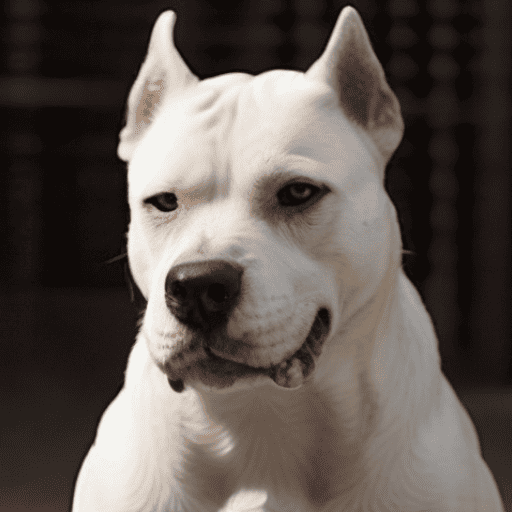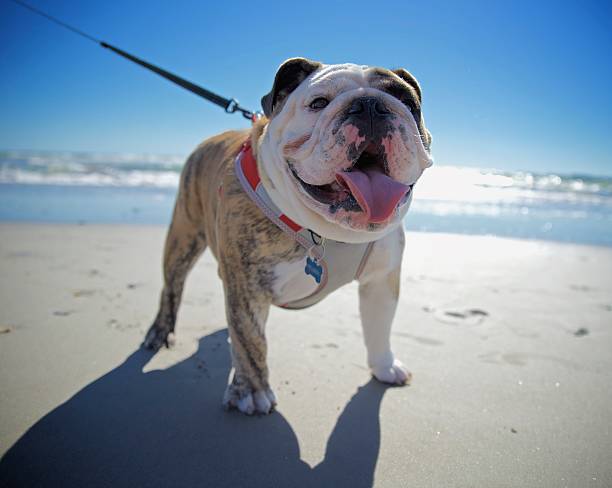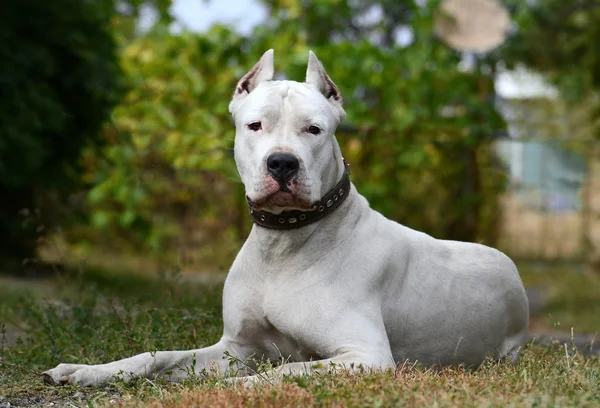The Cordoba Fighting Dog, known for its muscular build, tenacity, and fearless nature, captures the hearts of dog enthusiasts and families seeking a loyal and determined companion. With its storied history, protective instincts, and unwavering dedication, this breed has firmly established itself as a cherished guardian and a symbol of its Argentinean roots.

| Category (Explanation) | Breed Information |
|---|---|
| Year of Breed Conception | 1920s |
| Country of Origin | Argentina |
| Weight (Male) | 75-100 lbs (34-45 kg) |
| Weight (Female) | 60-85 lbs (27-39 kg) |
| Coat Type | Short, smooth |
| Color Variations | White with patches |
| Shedding Level | Low to moderate |
| Height (cm & in) | 58-69 cm (23-27 inches) |
| Breed Size | Large |
| Trainability | Moderate |
| Mental Needs | Moderate |
| Intelligence Level | Moderate |
| Energy Level | Moderate to high |
| Agility | Moderate |
| Loyalty | High |
| Playfulness | Moderate to high |
| Exercise Needs | Regular exercise and play |
| Guarding Proficiency | High |
| Sociability with Children | Moderate to high |
| Barking Level | Low to moderate |
| Digging Tendency | Low |
| Destructive Behavior | Low to moderate |
| Drooling Level | Moderate |
| Obedience Level | Moderate |
| Apartment Friendly | No |
| Inherent Prey Drive | High |
| Physical Risk to Others | Moderate to high |
| Travel Fatality Risk | Moderate |
| Allergen Potential | Low (considered hypoallergenic) |
| Health Concerns | Hip dysplasia, joint issues |
| Average Life Expectancy | 9-15 years |










































































Woof Mastery is reader supported and our articles may contain affiliate links.
Instead of running third party ads that we have no control of we only use links from high-quality companies we are directly partnered with. Making use of these links come at no cost to you our reader, and in many cases have the extra benefit of discounted rates or sign up bonuses.
If you’re interested you can read more about our affiliate policy here.
We appreciate your support and always insure that the products and services we recommend are high-quality, helpful and relevant to the subject at hand!
The Cordoba Fighting Dog’s history is a reflection of a challenging past. Originating in Argentina in the early 20th century, this breed was unfortunately bred for dogfighting. Despite this dark history, some breed enthusiasts have worked to transition them into loving and loyal companions.
Their journey from a background of cruelty to becoming cherished family members showcases their adaptability and capacity for transformation.
Today, efforts are ongoing to restore the breed’s reputation, focusing on their loyalty and affectionate nature. Cordoba Fighting Dogs stand as a reminder of the importance of responsible breeding and rehabilitation, embodying the potential for change and redemption.

What sets the Cordoba Fighting Dog apart is its strong and fearless character, shaped by its history in Argentina. Originally bred for hunting large game and serving as guardians, these dogs exhibit remarkable bravery and tenacity. Cordoba Fighting Dogs have a powerful presence and a natural protective instinct that makes them formidable family protectors.
However, beyond their protective nature, they form deep and unbreakable bonds with their owners, displaying unwavering loyalty. Their unique combination of bravery, dedication, and loyalty makes Cordoba Fighting Dogs truly special companions, ready to stand by their family’s side in any situation.
The traditional role of the Cordoba Fighting Dog included hunting and herding tasks, where their agility and strength were valuable. They excelled as versatile working dogs, contributing to various agricultural activities. Today, they continue to thrive as affectionate family pets, offering both companionship and athleticism to their owners.
Cordoba Fighting Dogs are renowned for their fearless and determined personalities. This breed possesses a strong prey drive and an inherent courage that often leaves a lasting impression. They are naturally reserved, even aloof, when encountering unfamiliar faces, showcasing their protective instincts.
However, their loyalty to their owners knows no bounds. Their intelligence and determination are clear in their actions, which can make them trainable, although they require experienced handlers. Cordoba Fighting Dogs embody an unwavering sense of duty, displaying not only courage but also a deep commitment to safeguarding their loved ones.
Cordoba Fighting Dogs are characterized by their fearless and determined temperament. They possess a strong prey drive and an inherent courage that often leaves a lasting impression. They are naturally reserved, even aloof, when encountering unfamiliar faces, showcasing their protective instincts.
However, their loyalty to their owners knows no bounds. Their intelligence and determination are clear in their actions, which can make them trainable, although they require experienced handlers. Cordoba Fighting Dogs embody an unwavering sense of duty, displaying not only courage but also a deep commitment to safeguarding their loved ones.
Effective training and socialization are critical for managing their protective instincts and nurturing a well-balanced temperament in this breed.
Cordoba Fighting Dogs are medium-sized, agile dogs known for their well-proportioned and athletic build. Their broad, slightly domed head features a strong, well-defined jaw that reflects their determination and tenacity.
Their medium-sized, oval-shaped eyes are often dark, and they exude alertness and focus. Ears are medium-sized and may be cropped according to tradition.
These dogs have a short, smooth coat that offers low maintenance and comes in various solid colors, including white, black, and brindle. Their skin is tight and muscular, emphasizing their athletic and streamlined physique.
The neck is strong and powerful, leading to a deep chest and robust, straight legs, ensuring agility and endurance. The tail is typically docked, contributing to their balanced and harmonious appearance.
In terms of size, males stand around 20-24 inches (51-61 cm) at the shoulder, and females are slightly smaller. Weight typically ranges from 70 to 90 pounds (32-41 kg) for males and slightly less for females. Cordoba Fighting Dogs exhibit an appearance that highlights their agility, stamina, and tenacity, making them agile and determined companions.
Overall, the Cordoba Fighting Dog boasts a well-proportioned, athletic physique. Their appearance exudes power, agility, and a fierce determination. Within this breed, males typically carry a more imposing presence compared to females, underscoring their history as tenacious hunting and working dogs.
Cordoba Fighting Dogs exhibit a range of color variations, contributing to their unique appearance. The most common color variations for Cordoba Fighting Dogs include:
Cordoba Fighting Dogs typically have a low shedding level. They are not known to be heavy shedders, and their shedding is generally minimal year-round. Occasional grooming and brushing with a soft bristle brush can help control shedding and maintain their coat’s health.
Factors that affect shedding in Cordoba Fighting Dogs can be influenced by genetics, overall health, and diet. Providing a balanced diet with essential nutrients can contribute to a healthier coat and potentially reduce shedding. Regular exercise and mental stimulation are important for their overall health and coat condition.
Cordoba Fighting Dogs, historically known for their bravery, showcases a coat that, while short, is thick and requires dedicated care.
Brushing: Weekly sessions with a deshedding tool, followed by a firm bristle brush, are essential for skin health and shedding management.
Bathing: Due to their historical combatant role, they can often be active and might benefit from monthly baths, using a hydrating dog shampoo.
Ears: Their ears, which have a distinct curve, can become a reservoir for moisture and dirt. Regular cleaning, preferably weekly, and routine checks are advised.
Nails: Their agile nature demands well-kept nails. Regular trims, preferably bi-weekly, ensure they maintain their stride without discomfort.
Teeth: Regular dental checks, combined with daily brushing and dental chews, can significantly reduce the risk of oral ailments.
Wrinkle Care: Any wrinkles or folds, predominantly around the face, need daily cleaning and drying.
Eye Care: Their expressive eyes should be checked daily, ensuring they remain free of any irritants.
Cordoba Fighting Dogs, also known as Dogo Cordobes, have a high activity level. They are known for their strength and courage. Here are some key points to consider about their activity level:
Cordoba Fighting Dogs possess a moderate level of intelligence, characterized by adaptability, problem-solving abilities, and a strong desire to please their owners. Here are key points about their intelligence:
The Cordoba Fighting Dog may have a controversial history, but their intelligence is evident in their trainability, problem-solving skills, and loyalty. They excel as devoted and protective family companions. Training, socialization, and mental stimulation are essential to help them reach their full potential.
Cordoba Fighting Dogs demand mental tasks. Opt for complex toys, command lessons, or duo plays.
Social Interaction: Cordoba Fighting Dogs need human companionship to counteract their aggressive tendencies. Regular bonding is key.
Exercise: These dogs have high energy levels. Daily physical workouts are crucial to prevent restlessness.
Training and Obedience: Cordoba Fighting Dogs, given their past, require consistent, firm, but compassionate training. Positive methods are essential.
Routine and Structure: A well-defined daily structure is crucial for Cordoba Fighting Dogs to ensure stability and security.
Affection and Attention: Despite their tough exterior, Cordoba Fighting Dogs crave affection. It’s vital to spend quality time with them.
Socialization: Cordoba Fighting Dogs require early and positive socialization to counteract their aggressive tendencies and be well-adjusted.
Safe Environment: Cordoba Fighting Dogs, given their history, need a secure and peaceful environment to relax and feel protected.
Consistency: Given their history, consistency in routines and commands is crucial for Cordoba Fighting Dogs to feel stable and secure.
Enter The Woof Mastery

Before welcoming a Cordoba Fighting Dog into your home, it’s important to understand their unique needs. These dogs are known for their strength and courage. They require regular exercise and mental stimulation to thrive. Training and socialization are vital to harness their strong protective instincts.
Be prepared for potential health concerns, including heart conditions. Responsible ownership involves providing ample love, attention, and a secure environment for these loyal and fearless companions.
Cordoba Fighting Dogs, historically bred for aggressive purposes, can present a potential physical danger to others if not adequately socialized, trained, or managed. It’s essential to understand that a dog’s behavior is influenced by factors such as individual temperament, upbringing, training, and owner responsibility. Here are some considerations regarding their potential physical danger:
Cordoba Fighting Dogs are renowned for their fearless and determined personalities. This breed possesses a strong prey drive and an inherent courage that often leaves a lasting impression. They are naturally reserved, even aloof, when encountering unfamiliar faces, showcasing their protective instincts.
However, their loyalty to their owners knows no bounds. Their intelligence and determination are clear in their actions, which can make them trainable, although they require experienced handlers. Cordoba Fighting Dogs embody an unwavering sense of duty, displaying not only courage but also a deep commitment to safeguarding their loved ones.
Cordoba Fighting Dogs, historically known for their fighting prowess, possess attributes influencing their relationship with water. Here are pertinent factors:
While some Cordoba Fighting Dogs might adapt to water and learn to swim, always approach aquatic endeavors with caution and prioritize their well-being.
Cordoba Fighting Dogs, while now extinct, were known for certain vocal characteristics. Here’s a hypothetical insight into their sounds:
For those who once owned or interacted with a Cordoba Fighting Dog, understanding their vocal habits and the reasons behind them would’ve been vital. Positive reinforcement would’ve been instrumental in managing their potentially aggressive vocal behavior.
Cordoba Fighting Dogs thrive in homes where they receive love, structure, and opportunities for socialization. Here are some ideal living conditions for Cordoba Fighting Dogs:
Challenges:
When it comes to travel fatality risk for Cordoba Fighting Dogs, consider the following potential constraints:
By addressing these potential constraints and taking necessary precautions, you can help ensure the safe travel of your Cordoba Fighting Dog and minimize travel-related risks.
Cordoba Fighting Dogs, now extinct but ancestors to the Dogo Argentino, were known to have specific health concerns. While not all individuals experienced these issues, it was essential for their owners to be aware of potential health problems and work with veterinarians. Common health concerns included:
Regular veterinary check-ups, a balanced diet, proper exercise, and responsible breeding practices were essential to mitigate these health concerns. It was crucial for Cordoba Fighting Dog owners to monitor their pets’ health and address any issues promptly.
Ensuring the right nutrition is essential for the optimal health and vitality of Cordoba Fighting Dogs. Below are some dietary guidelines and best practices tailored for this specific breed:
Breed-Specific Laws (BSL): Cordoba Fighting Dogs, due to their historical use in dog fighting, might frequently face breed-specific laws (BSL) in many jurisdictions. Typically, local or municipal authorities implement these regulations, which can vary significantly.
Types of Restrictions: Under BSL, Cordoba Fighting Dogs might see restrictions such as mandatory spaying/neutering, special licensing, liability insurance requirements, muzzling in public zones, and at times, ownership bans. The exact nature of these restrictions is often region-specific.
Rationale for BSL: Concerns about public safety and perceived threats from certain breeds, often based on historical contexts, drive the implementation of BSL. Cordoba Fighting Dogs, given their name and past, can be prominently featured in such laws.
Controversy: The issue of BSL remains hotly debated, with critics suggesting it might be too general and unfairly target breeds. Many believe emphasis should be on individual dog behavior and responsible ownership.
Local Regulations: Before acquiring a Cordoba Fighting Dog, it’s vital to understand and comply with any local breed-specific regulations, which can be determined by consulting local animal control or governing bodies.
Woof Mastery is reader supported and our articles may contain affiliate links.
Instead of running third party ads that we have no control of we only use links from high-quality companies we are directly partnered with. Making use of these links come at no cost to you our reader, and in many cases have the extra benefit of discounted rates or sign up bonuses.
If you’re interested you can read more about our affiliate policy here.
We appreciate your support and always insure that the products and services we recommend are high-quality, helpful and relevant to the subject at hand!
Myth 1: Cordoba Fighting Dogs are Aggressive by Nature
Myth 2: They are High-Energy Dogs
Myth 3: They Can’t Tolerate Cold Weather
Myth 4: They are Not Good with Children
Myth 5: They Shed Excessively
Myth 6: They Don’t Require Training
Myth 7: They are Always Good with Other Dogs
Myth 8: They Are All the Same Size
Myth 9: They are Unhealthy Dogs
Myth 10: They are Always Clingy
The Cordoba Fighting Dog holds cultural significance in various contexts:
While there may not be as many famous Cordoba Fighting Dog owners as there are for other dog breeds, here are a few notable individuals who have been associated with Cordoba Fighting Dogs:
Cordoba Fighting Dogs, like many other dog breeds, have faced several threats and challenges over the years. Some of the significant threats and issues that have affected the breed include:
The Cordoba Fighting Dog is believed to have been developed from a combination of various breeds, with the primary ancestors being various fighting breeds brought to Argentina. The breed’s development centered in Cordoba, Argentina, mainly for the purpose of dog fighting. The specific breeds and strains that contributed to the Cordoba Fighting Dog’s development include:
Cordoba Fighting Dogs are a unique breed with a storied history. While originally bred for a specific purpose, their loyal and affectionate nature makes them exceptional family companions. With their striking appearance and loving disposition, they seamlessly integrate into our lives, becoming cherished members of our households.
These dogs have protective instincts that can make them reliable watchdogs. Cordoba Fighting Dogs are known for their adaptability, thriving in various living conditions, and requiring only minimal grooming. Their athletic prowess and playful spirit cater to active individuals and families, making them excellent playmates. Their intelligence shines in various activities and training.
Beyond their physical attributes, Cordoba Fighting Dogs bring a unique charm to every household, filling the air with their presence. Their versatility is a testament to their adaptability, transitioning effortlessly from beloved family pets to diligent working dogs.
Most importantly, Cordoba Fighting Dogs offer profound and unconditional love, forging an unbreakable bond that enriches our lives. If you’re seeking a loyal and affectionate companion with a unique history, embrace the love and devotion of a Cordoba Fighting Dog.